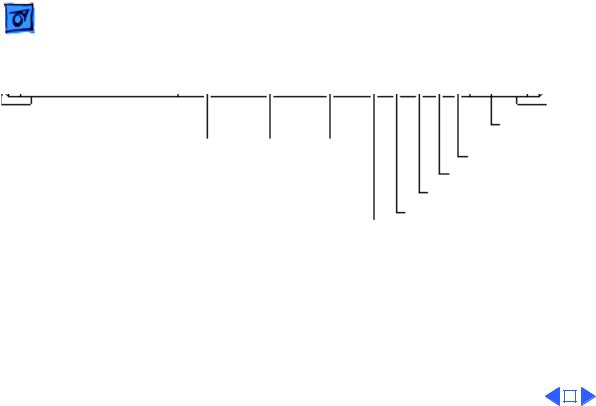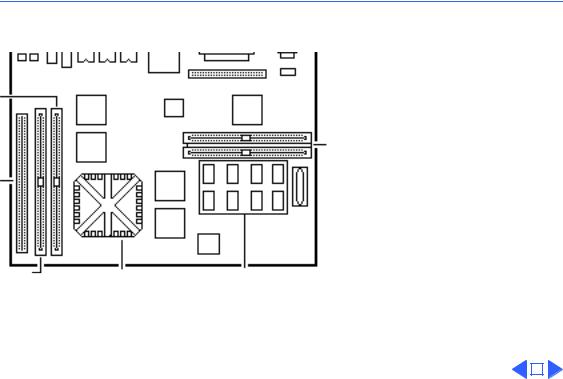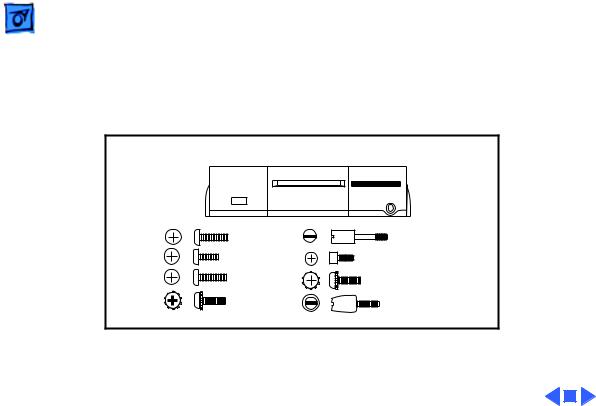Apple Macintosh Powermac Performa 6100 Service Manual

K Service Source
Macintosh Performa 6100
Series
Macintosh Performa 6110CD, 6112CD, 6115CD,
6116CD, 6117CD, 6118CD

K Service Source
Basics
Macintosh Performa 6100 Series

Basics |
Power Macintosh System Overview - 1 |
|
|
|
|
Power Macintosh System Overview
PowerPC microprocessors are a family of processors built on reduced instruction-set computing (RISC) technology. RISC processors streamline the internal workings of computers. Whereas traditional (complex instruction-set computing, or CISC) processors contain a wide variety of instructions to handle many different tasks, RISC processors contain only those instructions that are used most often. When a complex instruction is needed, a RISC processor builds it from a combination of basic instructions.
RISC processors are designed to execute these basic instructions extremely quickly. The performance gains achieved by speeding up the most-used instructions more than compensate for the time spent creating less-used instructions.

Basics |
Power Macintosh System Overview - 2 |
|
|
|
|
|
Previously, RISC technology had been used only in high-end |
|
|
workstations and commercial database servers. With the |
|
|
introduction of Macintosh PowerPC computers, Apple |
|
|
succeeded in bringing RISC technology to personal |
|
|
computing. |
|
Key Points
Three key points to remember about a PowerPC processorbased Macintosh system: It's a Macintosh; it's compatible; it offers tremendous performance.
Apple's PowerPC computers feature the same user interface as their 680x0-based predecessors. Users can mix RISCbased and 680x0-based Macintosh systems on the same network and exchange files and disks between them. In addition, users can run both 680x0 and native PowerPC applications on the same Power Macintosh system simultaneously.

Basics |
Power Macintosh System Overview - 3 |
|
|
|
|
|
Compatibility is not limited just to applications. INITs, |
|
|
CDEVs, drivers, and other Macintosh utility software also |
|
|
work on PowerPC processor-based Macintosh systems. So do |
|
|
AppleTalk devices (such as printers), SCSI devices (such as |
|
|
hard drives and scanners), ADB devices (such as mice, |
|
|
trackballs, and keyboards), and other Macintosh cards and |
|
|
peripherals. |
|
|
The primary operating system for PowerPC processor- |
|
|
based Macintosh computers is System 7. The operating |
|
|
system has been optimized for the highest performance on |
|
|
the PowerPC processor. This optimization of System 7 |
|
|
benefits applications written for 680x0 systems as well as |
|
|
those developed specifically for PowerPC processor-based |
|
|
systems. |
|
|
And while PowerPC-based Macintosh systems running |
|
|
native applications offer two to four times the performance |
|

Basics |
Power Macintosh System Overview - 4 |
|
|
|
|
|
of the fastest 68040and 80486-based personal |
|
|
computers, the real promise of PowerPC technology is that |
|
|
it enables Apple and other developers to deliver new |
|
|
software capabilities on Macintosh systems that were |
|
|
previously available only on high-end workstations. |
|
Troubleshooting Tips
When troubleshooting Power Macintosh systems, keep in mind the following:
1 If a Power Macintosh system does not power up, you should first attempt to reset the logic board. Instructions are provided in the Additional Procedures chapter.
2 With Power Macintosh computers, you must install noncomposite RAM SIMMs only, and the RAM SIMMs must be installed in like pairs (that is, the same size and speed). Additional troubleshooting information is

Basics |
Power Macintosh System Overview - 5 |
|
|
|
|
provided in the Symptom Charts section of the Troubleshooting chapter under the “System” topic heading.
3If a Power Macintosh system has bad RAM SIMMs installed, you will not hear death chimes. Instead, a dialog box will appear alerting you to the fact that a bad RAM SIMM has been detected. Additional troubleshooting information is provided in the Symptom Charts section of the Troubleshooting chapter under the “System” topic heading.
4If the system hangs shortly after installing a new NuBus card, contact the vendor to verify that the card is compatible with the Power Macintosh system or to see if there is a software upgrade available. If the NuBus card is an Apple manufactured product, refer to the Service Tech Info Library for more information.

Basics |
Product Configurations - 6 |
|
|
|
|
Product Configurations
All configurations are at introduction of the product.
Performa 6110CD
• Memory: 8 MB of RAM
• Drives: Internal Apple 1.4 MBSuperDrive, internal 250 MB SCSI hard drive, internal AppleCD 300i Plus drive
• Modem: Teleport send-fax/data modem
• Monitor: Apple Multiple Scan 15 Display
Performa 6112CD
• Memory: 8 MB of RAM
• Storage: Internal Apple 1.4 MB SuperDrive, internal 250 MB SCSI hard drive, internal AppleCD 300i Plus drive
• Modem: Teleport send-fax/data modem
• Monitor: Apple Multiple Scan 15 Display

 Basics Product Configurations - 7
Basics Product Configurations - 7
Performa 6115CD
• Memory: 8 MB of RAM
• Drives: Internal Apple 1.4 MBSuperDrive, internal 350 MB SCSI hard drive, internal AppleCD 300i Plus drive
• Modem: Teleport send-fax/data modem
• Monitor: Apple Multiple Scan 15 Display
Performa 6117CD
• Memory: 8 MB of RAM
• Storage: Internal Apple 1.4 MB SuperDrive, internal 350 MB SCSI hard drive, internal AppleCD 300i Plus drive
• Modem: Teleport send-fax/data modem
• Monitor: Apple Multiple Scan 15 Display

 Basics Product Configurations - 8
Basics Product Configurations - 8
Performa 6118CD
• Memory: 8 MB of RAM
• Storage: Internal Apple 1.4 MB SuperDrive, internal 500 MB SCSI hard drive, internal AppleCD 300i Plus drive
• Modem: Teleport send-fax/data modem

Basics |
HDI-45 Pinouts - 9 |
|
|
|
|
HDI-45 Pinouts
This section includes an illustration of the HDI-45 video connector and a table containing the pinout descriptions.
Figure: HDI-45 Video Connector on the Logic Board

Basics |
HDI-45 Pinouts - 10 |
|||
|
|
|
|
|
|
|
Table: HDI-45 Pinouts |
||
|
|
|
|
|
|
Pin |
Description |
|
|
|
|
|
|
|
|
1 |
Analog audio ground |
|
|
|
|
|
|
|
|
2 |
Audio input shield |
|
|
|
|
|
|
|
|
3 |
Left channel audio input |
|
|
|
|
|
|
|
|
4 |
Right channel audio input |
|
|
|
|
|
|
|
|
5 |
Left channel audio output |
|
|
|
|
|
|
|
|
6 |
Right channel audio output |
|
|
|
|
|
|
|
|
7 |
Reserved |
|
|
|
|
|
|
|
|
8 |
Monitor ID sense line 1 |
|
|
|
|
|
|
|
|
9 |
Monitor ID sense line 2 |
|
|
|
|
|
|
|
|
10 |
Green ground (shield) |
|
|
|
|
|
|
|

Basics |
HDI-45 Pinouts - 11 |
|||
|
|
|
|
|
|
|
|
|
|
|
Pin |
Description |
|
|
|
|
|
|
|
|
11 |
Green video output (75Ω) |
|
|
|
|
|
|
|
|
12 |
Video input power ground |
|
|
|
|
|
|
|
|
13 |
Power for camera +5 V |
|
|
|
|
|
|
|
|
14 |
Reserved |
|
|
|
|
|
|
|
|
15 |
Reserved |
|
|
|
|
|
|
|
|
16 |
Reserved |
|
|
|
|
|
|
|
|
17 |
Reserved |
|
|
|
|
|
|
|
|
18 |
Monitor ID sense line 3 |
|
|
|
|
|
|
|
|
19 |
S-video input shield |
|
|
|
|
|
|
|
|
20 |
S-video input luminance (Y) |
|
|
|
|
|
|
|
|
21 |
S-video input chroma (C) |
|
|
|
|
|
|
|

Basics |
HDI-45 Pinouts - 12 |
|||
|
|
|
|
|
|
|
|
|
|
|
Pin |
Description |
|
|
|
|
|
|
|
|
22 |
Reserved |
|
|
|
|
|
|
|
|
23 |
Reserved |
|
|
|
|
|
|
|
|
24 |
Reserved |
|
|
|
|
|
|
|
|
25 |
Reserved |
|
|
|
|
|
|
|
|
26 |
Red ground (shield) |
|
|
|
|
|
|
|
|
27 |
Red video output (75Ω) |
|
|
|
|
|
|
|
|
28 |
I 2C data signal |
|
|
|
29 |
I 2C clock signal |
|
|
|
30 |
Reserved |
|
|
|
|
|
|
|
|
31 |
Monitor ID |
|
|
|
|
|
|
|
|
32 |
Monitor ID |
|
|
|
|
|
|
|

Basics |
HDI-45 Pinouts - 13 |
|||
|
|
|
|
|
|
|
|
|
|
|
Pin |
Description |
|
|
|
|
|
|
|
|
33 |
Vertical sync signal |
|
|
|
|
|
|
|
|
34 |
Composite sync signal |
|
|
|
|
|
|
|
|
35 |
ADB power +5 V |
|
|
|
|
|
|
|
|
36 |
ADB ground |
|
|
|
|
|
|
|
|
37 |
ADB data |
|
|
|
|
|
|
|
|
38 |
Keyboard switch |
|
|
|
|
|
|
|
|
39 |
Reserved |
|
|
|
|
|
|
|
|
40 |
Reserved |
|
|
|
|
|
|
|
|
41 |
Monitor ID |
|
|
|
|
|
|
|
|
42 |
Horizontal sync signal |
|
|
|
|
|
|
|
|
43 |
Video sync ground |
|
|
|
|
|
|
|

Basics |
HDI-45 Pinouts - 14 |
|||||
|
|
|
|
|
||
|
|
|
|
|||
|
Pin |
Description |
|
|
|
|
|
|
|
|
|||
|
44 |
Blue ground (shield) |
|
|
|
|
|
|
|
|
|||
|
45 |
Blue video output (75Ω) |
|
|
|
|
|
|
|
|
|
|
|
|
|
|
|
|
|
|
|
|
|
|
|
|
|

Basics |
Rear Panel Connectors - 15 |
|
|
|
|
Rear Panel Connectors
|
|
Reset/ |
|||
Ethernet SCSI |
HDI-45 |
Interrupt |
|||
Sound In |
|||||
|
Video |
||||
|
ADBSound Out |
||||
|
|
||||
|
|
Modem |
|||
|
Printer |
|
|
|
|
|
|
|
|
|
|
|
|
|
|
|
|

 Basics Logic Board Connectors - 16
Basics Logic Board Connectors - 16
Logic Board Connectors
Sound Out |
Serial Ports |
|
|
|
AV Display |
SCSI Ethernet |
|
Sound In |
ADB |
Connector |
|
Cache SIMM
DRAM
SIMMs
601 PDS
4 MB ROM |
601 Chip |
8 MB Soldered DRAM |
|
|
|
|
|
|
|
|
|

Basics |
6100 Screws - 17 |
|
|
|
|
6100 Screws
Quadra 610 WGS 60/cent /Quadra660PM 6100 /WGS 6150
410-1308 |
450-0032 |
NuBus Adapter |
416-1306 |
844-0018 |
Screw Supper Drive |
416-1310 |
922-0401 |
CD-ROM Carrier |
440-6105 |
922-0995 |
Cover Thumb Screw |

K Service Source
Specifications
Macintosh Performa 6100 Series

|
Specifications |
Processor - 1 |
|||
|
|
|
|
||
|
|
Processor |
|||
CPU |
60 MHz PowerPC 601 RISC microprocessor |
||||
|
|
Built-in MMU and FPU |
|||
|
|
32K of on-chip cache memory |
|||
|
|
Requires system software version 7.5 or later |
|||
|
|
|
|
|
|
|
|
|
|
|
|

Specifications |
Memory - 2 |
|
|
|
|
RAM
ROM
Cache
Clock/Calendar
Memory
8 MB RAM soldered on board; 2 SIMM sockets on logic board, expandable to 72 MB (a pair of same-size, 80 ns or faster, 72-pin, non-composite SIMMs); 16 MB configuration has two 4 MB SIMMs installed
Note: SIMMs must be installed in pairs of the same size and speed. Install noncomposite SIMMS only.
4 MB installed on SIMM socket
32K of on-chip cache; optional 256K level 2 cache available
CMOS custom chip with long-life lithium battery

Specifications |
Disk Storage - 3 |
|
|
|
|
Floppy Drive
Hard Drive
Disk Storage
1.4 MB Apple SuperDrive Manual Insert
Performa 6110 and Performa 6112: 250 MB hard drive Performa 6115 and Performa 6117: 350 MB hard drive Performa 6118: 500 MB hard drive
CD-ROM |
Internal AppleCD 300i Plus CD-ROM drive |
|
|
|
|
|
|
|

Specifications |
I/O Interfaces - 4 |
|
|
|
|
SCSI
Serial
Apple Desktop Bus
Expansion Slot
I/O Interfaces
One SCSI port; DB-25 connector
Supports a maximum of six external SCSI devices (five when CDROM is installed)
Two RS-232/RS-422 LocalTalk/GeoPort serial ports; mini DIN- 9 connectors (backward compatible with mini DIN-8 connectors)
One Apple Desktop Bus (ADB) port; mini DIN-4 connector Maximum power draw 500 mA; maximum of three devices total
Internal expansion slot supports either a processor-direct slot card or 7-in. NuBus card (with appropriate adapter)

|
Specifications |
I/O Interfaces - 5 |
|||
|
|
|
|
||
Ethernet |
One built-in AUUI-15 Ethernet port |
||||
Sound |
16-bit stereo in and out |
||||
|
|
Sample rates of 48, 44.1, 24, and 22.05 kHz |
|||
|
|
Input/output line level: 1 V peak-to-peak |
|||
|
|
Input/output signal-to-noise ratio (SNR): 82 dB with no audible |
|||
|
|
discrete tones |
|||
|
|
Bandwidth: 20 Hz-20 kHz (± 2 dB) at 44.100 kHz sample rate |
|||
|
|
THD+N (total harmonic distortion plus noise): less than 0.05%, |
|||
|
|
measured 20Hz-20kHz with a 1-Vrms sine wave input |
|||
Video |
One HDI-45 DRAM-based video port on logic board supports |
||||
|
|
direct connection to Apple AudioVision monitors and with HDI- |
|||
|
|
45-to-DB-15 adapter (included) supports 12-inch, |
|||
|
|
13-inch, 14-inch, 15-inch portrait, 16-inch, and 17-inch |
|||
|
|
monitors. |
|||
|
|
|
|
|
|
|
|
|
|
|
|

|
Specifications |
I/O Devices - 6 |
|||
|
|
|
|
||
|
|
I/O Devices |
|||
Keyboard |
Apple Design Keyboard |
||||
Mouse |
ADB Mouse II; draws up to 10 mA |
||||
|
|
|
|
|
|
|
|
|
|
|
|
